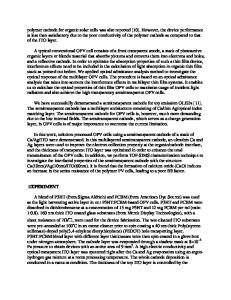Tandem Photovoltaic Cells with Amorphous Silicon Cells and Organic Photovoltaic Cells
- PDF / 881,152 Bytes
- 6 Pages / 612 x 792 pts (letter) Page_size
- 90 Downloads / 344 Views
Tandem Photovoltaic Cells with Amorphous Silicon Cells and Organic Photovoltaic Cells Taehee Kim, Jun Hong Jeon, Seung Hee Han, Doh-Kwon Lee and Kyungkon Kim Solar Cell Center, Energy Division, Korea Institute of Science and Technology, P.O. Box 131,Cheongryang, Seoul 136-791, Korea ABSTRACT We demonstrate series-connected tandem photovoltaic cells consisting of hydrogenated amorphous silicon (a-Si:H) solar cells and polymer-based organic photovoltaic (OPV) cells. One of the limiting factors of a-Si:H solar cells is their narrow absorption spectrum as compared with that of crystalline silicon solar cells. In order to overcome this limitation, we fabricated a hybrid tandem solar cell by employing a solution-processed OPV subcell based on a low bandgap semiconducting polymer onto the a-Si:H subcell. It was found that the interfacial property of the hole transporting intermediate layer between the subcells strongly affects the photovoltaic property of the tandem cells. By using MoO3 as an efficient hole transporting intermediate layer instead of the conventional conducting polymer, we obtained the power conversion efficiency of 1.84% and the open-circuit voltage (VOC) of 1.50 V which corresponds closely to the sum of the VOCs of the subcells. INTRODUCTION Thin-film solar cells based on hydrogenated amorphous silicon (a-Si:H) have gained serious attention because of their considerable potential as low-cost renewable energy resources with the low-temperature processing and capability to make large-area devices. Since Carlson and Wronski announced the first experimental a-Si:H solar cell in 1976 with a power conversion efficiency (PCE) of 2.4%,1 significant improvement of the a-Si:H solar cells had been achieved a PCE higher than 9% during the past decades.2,3 Although a-Si:H solar cells yield relatively high open-circuit voltages (VOC) and fill factors (FF), the PCE of a-Si:H solar cells is mainly limited by their low short-circuit current density (JSC) due to their narrow absorption spectrum as compared with that of the crystalline silicon solar cells.3,4 In order to improve the efficiency by utilizing the wider solar spectrum, a tandem solar cell using the so-called micromorph concept with an a-Si:H front cell and a microcrystalline silicon (μc-Si:H) back cell was developed.3,5 However, μc-Si:H has a low absorption coefficient and hence the even thicker absorber layer is required to obtain sufficient absorption and photocurrent generation. The formation of the thick μc-Si:H absorber layer leads to the high production cost and the low throughput. It is needed to develop new photovoltaic systems with the high efficiency and low production cost that can replace the μc-Si:H. Solution-processible bulk-heterojunction organic photovoltaic (OPV) cells have attracted much attention during the last few years and are becoming one of the promising future photovoltaic technologies. Recently, new semiconducting polymers having the low bandgaps have been synthesized and OPV cells based on the low bandgap polymers have remarkably prog
Data Loading...







